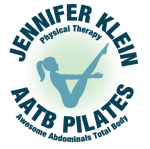Knee pain can prevent people from being active for months, even when it has been iced, rested, an exercised to strengthen muscles around the knee. The solution to correcting the lower body alignment is with a Pilates program.
Pain under the kneecap is common among active adults, and the usually symptom is pain behind or around the kneecap when sitting for long periods, squatting, or walking down stairs. People with these symptoms do not usually seek help for months because there was not an obvious injury. The pain can be intensified with problems like pronation (feet rolled inward), genu valgus (knock-knees), and femoral anteversion (inwardly rotated hips).
Women are more susceptible than men because they have a wider pelvis that make maintaining lower-body alignment difficult. It is crucial to identify and correct this problem to ease pain and to avoid further knee damage. Proper lower-body alignment helps minimize stress on the knee by allowing the quadriceps muscles stabilize the kneecap. The best lower-body alignment is maintained with strong abdominal and back muscles, adequate lower-body strength and flexibility, and good movement awareness. The main muscles to improve lower-body alignment include hip abductors, hip external rotators, and lower abdominal muscles. Flexibility in the hamstrings and iliotibial band (which runs down the outside of the thigh) will assist in correcting kneecap movement. Be aware about your lower-body alignment during all Pilates exercises. Ideally, when performing Pilates footwork in second position, the pelvis should remain neutral as the thighs rotate slightly outward, lining up the center of the knees with the second toes. The weight should be evenly distributed through the feet. If you’re experiencing knee pain, the Pilates exercises should focus on controlling hip and pelvis alignment in a non-weight-bearing position before you bear weight. The exercises should be pain free. To reduce kneecap compression during bent-knee movements, imagine a line perpendicular to your toes and do not allow the knees to move past it. If pain persists, consult a doctor to determine the cause of pain and supervise your exercise program.
Pilates may work well in combination with other modes of therapy, such as deep tissue massage or strength training. Your Physical Therapist may use ice, ultrasound, and/or electrical stimulation to help control pain. With proper instruction, Pilates is a safe and effective way to address lower-body alignment problems that lead to knee pain and can help people with knee pain return to an active, pain-free lifestyle.

Recent Comments